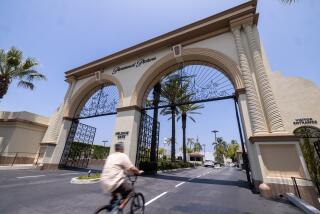VIDEO FILE : VIDEODISC RETURN: YOU CAN SEE CLOSELY NOW
The videodisc is alive and well and making a comeback of sorts. Less than a year after RCA gave up on one form of the video technology, the laser-optical videodisc is making news these days.
Earlier this month, Pioneer unveiled the revolutionary CLD 900 combination laserdisc and compact audio disc player. And last week, a new way of looking at traditional feature films on discs was unveiled at the American Film Institute in Hollywood.
Roger Smith and Bill Stein of Criterion Inc. demonstrated disc versions of two of Hollywood’s greatest classic films, “Citizen Kane” and “King Kong.” What makes the new versions unique is that they are designed to be seen very closely--frame by frame, in fact--and there is a whole lot more information on the discs than just pictures and the sound track.
The films are recorded for playback in the standard-play mode of the laserdisc machine, which was abandoned for most disc movies in the early ‘80s when discs were seen as competing with videotapes and disc playing time was extended. That time extension, however, did away with stop-action, slow-motion, random search and other features peculiar to laserdiscs. Those are back in the new Criterion discs.
“Not every film lends itself to this,” Smith said. “A film that’s plot and dialogue doesn’t improve much.”
But, Smith said, visually rich productions, such as “Kane” or “Kong,” can offer viewers a whole new visual experience.
“Over time, we’re going to be seeing increasingly dense films visually,” Stein added.
“King Kong” is the more interesting of the two. Making use of the dual sound channels available on laserdiscs, Criterion’s version of “King Kong” features the traditional movie sound track on one channel and an ongoing film commentary on the other. Viewers may listen to either track they choose, even switching from one to the other. The commentary is by noted film historian Ron Haver of the County Museum of Art.
In addition to Haver’s commentary, “King Kong” also features a video essay on the making of the movie. A similar essay is at the end of “Citizen Kane.”
The movie prints used to make the discs are of exceptionally fine quality--so fine, in fact, that on a 19-inch Sony a detail in the opening sequence of “Citizen Kane,” lost on most broadcast and videocassette versions, could be seen easily on the disc. (Trivia buffs, here’s the question: In the opening scene there is a sign under the monkeys near the gate of Xanadu. What does the sign say? Answer below.)
Standard-play laserdiscs of “Star Wars” and “The Empire Strikes Back” are due out next month.
Neither of the Criterion discs is currently on sale in video stores. They can be ordered, however, from Criterion at 2222 S. Barrington Ave., Los Angeles 90064. “Kane” sells for $89.95; “Kong” for $74.95.
NOT NOW: California’s senior U.S. senator, Democrat Alan Cranston, jetted into town last week to give one of those occasional pep talks that Washington politicians deliver to movers and shakers of the entertainment business. The talks are sponsored by the Motion Picture Assn. of America.
The more substantive portion of the senator’s remarks at Jimmy’s restaurant in Beverly Hills Friday was devoted to the various tax-reform recommendations floating around the nation’s Capitol these days. Don’t expect any significant tax-reform effort until next year, after Congress has dealt with the federal deficit, the senator said.
Sidney Sheinberg, president of MCA Inc. (Universal Studios), took aim during Cranston’s post-speech question-and-answer period with an impassioned plea for retaining business’ investment tax credit. Loss of the credit, Sheinberg said, “would have a uniquely disastrous impact in California.”
At the heart of the complicated tax issue is the reliance that movie makers and TV producers have on the investment credit, which allows a 6.66% credit on funds invested in American-made movies. Several persons in attendance explained that certain provisions in the law allow up to 10% of the cost of a production to be written off for tax purposes.
“In network television, sometimes the only profit you can have is in the investment tax credit,” explained Ray Bennett of MGM/UA.
Although Cranston broadly endorsed the idea of tax reform (“The concept of a modified flat tax is, I think, very appealing,” he said), he shied away from any specifics about how any new tax law would be structured.
“I’m open on the details,” Cranston said of the investment credit.
VIDEO BRIEFLY: HBO has signed a new five-year contract to cover the All England Lawn and Tennis Club’s annual tournament at Wimbledon. This June’s tournament will mark the 10th anniversary of the pay-TV network’s coverage of the tennis classic.
Answer to the question above: “Bengal Tiger.”
More to Read
The biggest entertainment stories
Get our big stories about Hollywood, film, television, music, arts, culture and more right in your inbox as soon as they publish.
You may occasionally receive promotional content from the Los Angeles Times.










